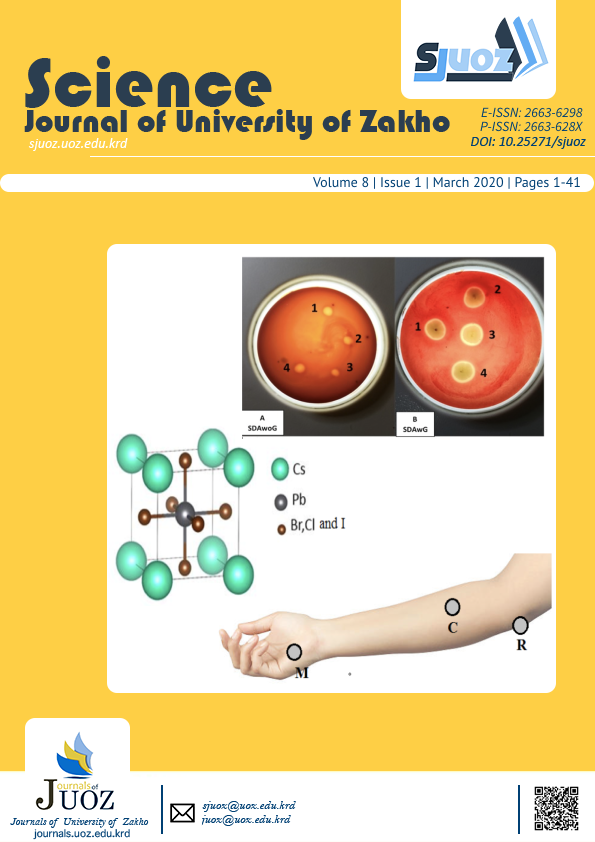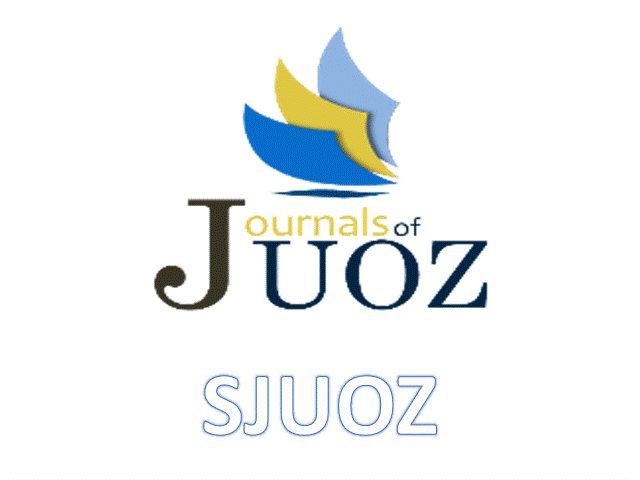Synergistic Effect of Different Plant Extracts and Antibiotics on Some Pathogenic Bacteria
DOI:
https://doi.org/10.25271/sjuoz.2020.8.1.653Keywords:
Antibacterial activity, Combination, Minimum inhibitory concentration (MIC), Plant extract, SynergisticAbstract
In this study, the antibacterial activity of methanol extract of henna (Lawsonia inermis) leaves, ethanol extract of pomegranate (Punica granatum) peel, volatile oil of sesame (Sesamum indicum) and peanut (Arachis hypogaea) were investigated against some Gram-positive and Gram-negative bacteria includingStaphylococcus aureus, Bacillus cereus, Escherichia coli and Acinetobacter sp. Henna extract was most effective substrate against all tested bacteria followed by pomegranate and peanut while sesame was less effective. All extracts were screened for their antibacterial activity in combination with commonly used antibiotics, including ciprofloxacin and erythromycin to evaluate synergistic effects using Minimum inhibitory concentrations (MIC) method which determined by microbroth dilution assays. Different interactions (synergistic and indifference) were observed between plant extracts and used antibiotics. The fractional inhibitory concentration (FIC) index ranged from 0.01 to 1.25 for B. cereus, 0.5 to 1 for P. aeruginosa, 0.01 to 0.3 for S. aureus and 0.06 to 0.25 for A. baumannii. The best synergistic capacity appeared between erythromycin and sesame. In vitro interaction between antimicrobial agents in combination with tested plant extracts showed synergistic effects. The MICs of each antibiotic was decreased to half when it is used in combination with tested plant extracts. This decreasing in MICs was observed in all plant extracts against tested bacteria as well as the extracts exhibited weak antibacterial activity alone.
Downloads
References
Abiramasundari P., Priya V., Jeyanthi G.P., Gayathri D.S. (2011). Evaluation of the Antibacterial activity of Cocculus hirsutus. HYGEIA - Journal for Drugs and Medicine, 3(2):26-31.
Agrawal P., Rai V., Singh R., B. (1996). Randomized, placebo-controlled, single-blind trial of holy basil leaves in patients with noninsulin-dependent diabetes mellitus. International Journal of Clinical Pharmacology and Therapeutics, 34:406-9.
Ahmed A. A., Mawlood S.I., Ismaeel A.S. (2010). Role of solvent and methods of extraction on the inhibitory effect of black seed extracts on Pseudomonas aeruginosa. Zanco Journal of Pure and Applied Sciences, 22, 3.
Ahmed, A. A. (2013). In vitro screening of Lactobacillus species from homemade yoghurt for antagonistic effects against common bacterial pathogens. Jordan Journal of Biological Sciences, 6(3):2011-16.
Aqil F., Khan M.S.A., Owais M. Ahmad I. (2005). Effect of certain bioactive plant extracts on clinical isolates of -lactamase producing methicillin resistant Staphylococcus aureus. Journal of Basic Microbiology. 45:106-114.
Berge, A. C. and M. Wierup, M. (2012). Nutritional strategies to combat Salmonella in mono-gastric food animal production. Animal, 6: 557-564.)
Chanda, S. and Rakholiya, K. (2011). Combination therapy: Synergism between natural plant extracts and antibiotics against infectious diseases. Science against microbial pathogens: communicating current research and technological advances. Formatex, 1: 520-9.
Cristani M., D'Arrigo M., Mandalari G., Castelli F., Sarpietro M.G., Micieli D., Venuti V., Bisignano G., Saija A., Trombetta D. (2007). Interaction of four monoterpenes contained in essential oils with model membranes: implications for their antibacterial activity. Journal of Agricultural and Food Chemistry, 25; 55(15):6300-8.
Cushnie T.P.T., Lamb A.J. (2005). Antimicrobial activity of flavonoids. International Journal of Antimicrobial Agents., 26: 343–56.
Dey D., Ray R. and Hazra B. (2015). Antimicrobial activity of pomegranate fruit constituents against drug-resistant Mycobacterium tuberculosis and ß-lactamase producing Klebsiella pneumonia (2015). Journal of Pharmaceutical Biology, 53 (10): 1474–80.
DiMasi J.A., Grabowski H.G., Hansen R.W. (2016). Innovation in the pharmaceutical industry: new estimates of R&D costs. Journal of Health Economics, 47: 20-33.
Drobniewski F.A. (1993). Bacillus cereus and related species. Clin. Microbiol. Rev. 6:324-338.
Duke J. A., JoBojeneschutz-Godwin M., DuCellier J., Duke P.A.K. (2003). CRC, Handbook of Medical Plant. Boca Raton: CRC Press, FL. 348.
Ennacerie F-Z., Filali F. R., Najia Moukrad, Ed-Dra A. (2017). Antibacterial synergistic effect of extracts of the organs of capparis spinosa and in combination with antibiotics. International Journal of Advanced Research, 5(9), 1238-47.
Farooqui A., Khan A., Borghetto I., Kazmi S.U., Rubino S., Paglietti B. (2015). Synergistic antimicrobial activity of Camellia sinensis and Juglans regia against multidrug-resistant bacteria. PLoS One, 10:e0118431.
Grohe K., Zeiler H.J., Metzger G. (1987). 7-amino-1-cyclopropyl-4-oxo-1, 4-dihydro-quinoline and naphthyridine 3-carboxylic acids and antibacterial agents containing these compounds. US patent, 4: 670.
Grytten J., Scheie A.A., Giertsen E. (1988). Synergistic antibacterial effects of copper and hexetidine against Streptococcus sobrinus and Streptococcus sanguis. Acta Odontologica Scandinavica, 46:181-3.
Harborne J.B. (1998). Phytochemical Methods A guide to modern techniques of plant analysis. Third Ed: Chapman & Hall.
Harborne S.B and Baxter A. (1995). Phytochemical Dictionary. A handbook of bioactive compounds from plants. Tylor and Francis. London.
Haroun M. and Al-Kayali R.S. (2016). Synergistic effect of Thymbra spicata L. extracts with antibiotics against multidrug-resistant Staphylococcus aureus and Klebsiella pneumoniae strains. Iranian Journal of Basic Medical Sciences, 19:1193-200.
Kamatou G.P.P., Viljoen A.M., van Vuuren S.F., van Zyl R.L. (2006). In vitro evidence of antimicrobial synergy between Salvia chamelaeagnea and Leonotis leonurus. South African Journal of Botany, 72:634–6.
Kelmanson J.E., Jäger A.K., Van Staden J. (2000). Zulu medicinal plants with antibacterial activity. Journal of Ethnopharmacology, 69(3):241-6.
Kotiranta A., Lounatmaa K., Haapsalo M. (2000). Epidemiology and pathogenesis of Bacillus cereus infections. Microbes Infection, 2:189–198.
Lalitha M.K. (2004). Manual on antimicrobial susceptibility testing. Indian Association of Medical Microbiologists, 46.
Levinson W, Jawetz E. (2002). Medical microbiology and immunology: Examination and board review. International. 7th ed., Lange Medical Books/McGraw-Hill, New York.
Liu G., Liang J., Wang X., Li Z. (2011). In vitro synergy of biochanin A and ciprofloxacin against clinical isolates of Staphylococuus aureus. Molecules, 16 (8):6656-66.
Liu, H.; Zhang, W.; Wu, Y.; Sun, L.; Wang, Y.; Liu, Y.; Zhang, X.; Hong, P.; Ji, H. (2017). Synergistic antimicrobial effect and mechanism of lipopeptides and tea polyphenols against Vibrio parahaemolyticus. Food Sciences, 38: 14-19.
Naz, S., Siddiqi, R., Ahmad, S., Rasool, S.A., and Sayeed, S.A.J. (2007). Antibacterial activity directed isolation of compounds from Punica granatum. Journal of Food Science, 72 (9): 341-5.
Olajuyigbe O. O., Afolayan a. J. (2012). Synergistic Interactions of Methanolic Extract of Acacia mearnsii de wild with antibiotics against bacteria of clinical relevance. International journal of molecular sciences, 13(7): 8915–32.
Pagliarulo C., De vito V., Picariello G. (2016). Inhibitory effect of pomegranate (Punica granatum) polyphenol extracts on the bacterial growth and survival of clinical isolates of pathogenic staphylococcus aureus and escherichia coli. Food chemistry, 190: 824–31.
Petersen P.J., Labthavikul P., Jones C.H., Bradford P.A. Kamatou G.P.P. (2006). In vitro antibacterial activities of tigecycline in combination with other antimicrobial agents determined by chequer board and time-kill kinetic analysis. Journal of Antimicrobial Chemotherapy, 57:573–6.
Prasad R.N., Viswanathan S., Devi J.R., Nayak V., Swetha V.C., Archana B.R., Parathasarathy N., Rajkumar J. (2008). Preliminary phytochemical screening and microbial activity of Samaea saman. Journal of Medicinal Plant Research, 2:268–70.
Roberts A.E., Maddocks S.E., Cooper R.A. (2012). Manuka honey is bactericidal against Pseudomonas aeruginosa and results in differential expression of oprF and algD. Microbiology, 158:3005-13.
Rosas-Burgos E. C., Burgos-Hernández A., Noguera-Artiaga L. (2017). Antimicrobial activity of pomegranate peel extracts as affected by cultivar, Journal of the Science of Food and Agriculture, 97(3): 802–10.
Rouveix B. (2007). Implications of multiple drug resistant efflux pumps of pathogenic bacteria. Journal of Antimicrobial Chemotherapy, 5(96):1208–9.
Sato Y., Shibata H., Arai T., Yamamoto A., Okimura Y., Arakaki N., Higuti T. (2004). Variation in synergistic activity by flavone and its related compounds on the increased susceptibility of various strains of methicillin-resistant Staphylococcus aureus to β-lactam antibiotics. International Journal of Antimicrobial Agents, 24:226–33.
Subramaniam P., Dwivedi S., Uma E. and Girish Babu K. L. (2012). Effect of pomegranate and aloe vera extract on streptococcus mutans: An in vitro study, Dental Hypotheses, 3 (3): 99–105.
Tsuchiya H., Sato M., Miyazaki T., Fujiwara S., Tanigaki S., Ohyama M., Tanaka T., Iinuma M. (1996). Comparative study on the antibacterial activity of phytochemical flavonones against methicillin-resistant Staphylococcus aureus, Journal of Ethnopharmacology, 50:27–34.
Usha P.T.A., Jose S., Nisha A.R. (2010). Antimicrobial drug resistance - a global concern. Veterinary World, 3:138-9.
Viuda-Martos M., Fernández-López J., Pérez-Álvarez J.A. (2010). Pomegranate and its many functional components as related to human health: a review. Comprehensive Reviews in Food Science and Food Safety, 9:635–54.
Yang Z.C., Wang B.C., Yang X.S., Wang Q., Ran L. (2005). The synergistic activity of antibiotics combined with eight traditional Chinese medicines against two different strains of Staphylococcus aureus. Colloids and Surfaces B, Biointerfaces, 41:79-81.
Downloads
Published
How to Cite
Issue
Section
License
Copyright (c) 2020 Suzan A. Sharif, Abdulilah S. Ismaeil, Akhter A. Ahmad

This work is licensed under a Creative Commons Attribution 4.0 International License.
Authors who publish with this journal agree to the following terms:
- Authors retain copyright and grant the journal right of first publication with the work simultaneously licensed under a Creative Commons Attribution License [CC BY-NC-SA 4.0] that allows others to share the work with an acknowledgment of the work's authorship and initial publication in this journal.
- Authors are able to enter into separate, additional contractual arrangements for the non-exclusive distribution of the journal's published version of the work, with an acknowledgment of its initial publication in this journal.
- Authors are permitted and encouraged to post their work online.








